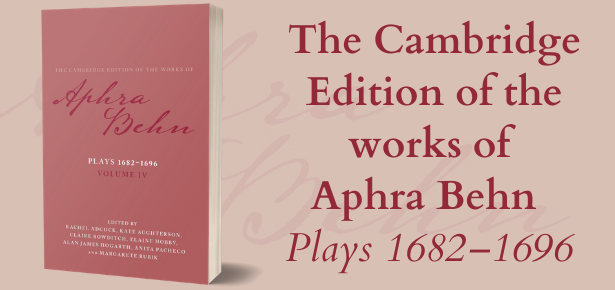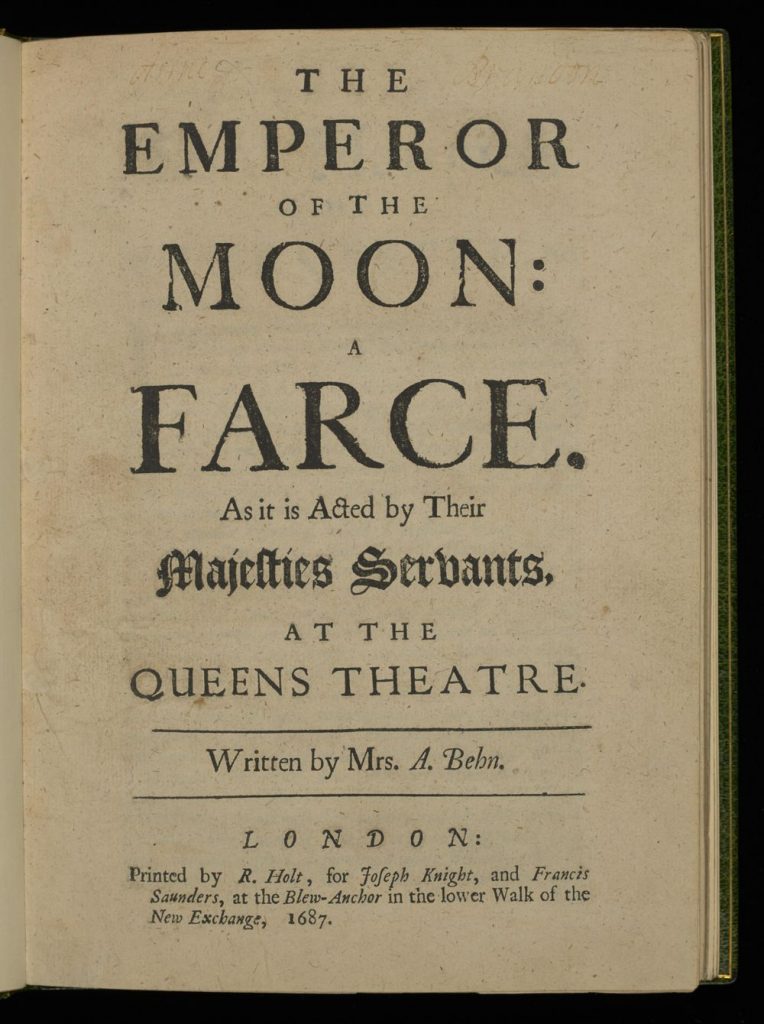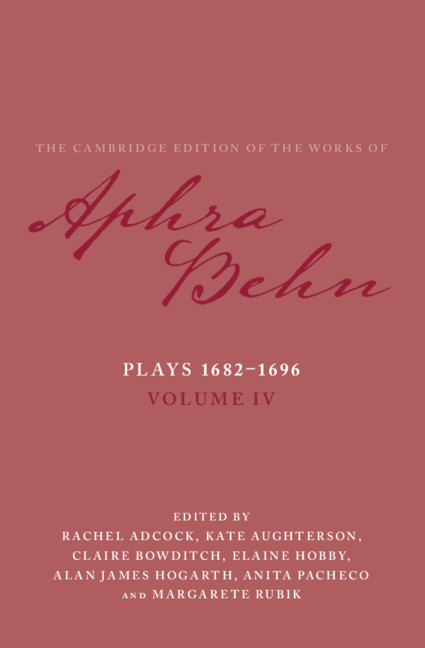
The five plays in Volume IV of the Cambridge Edition of the Works of Aphra Behn date from the final years of Behn’s professional career. Three of the plays were performed during her lifetime: The City-Heiress (1682), The Luckey Chance (1686) and The Emperor of the Moon (1687). Two works appeared on the stage and in print after her death in April 1689: The Widdow Ranter (1689) and The Younger Brother (1696), testifying to Behn’s posthumous popularity. The Cambridge edition of Behn will, upon completion, provide the complete collection of her works in eight volumes, organised by genre and by time period. In undertaking this new scholarly edition, we felt that each volume, and each text, should be able to standalone, accessible to readers with a specific generic interest, or with a focus on a particular decade. The editors of the five plays in this volume, therefore, have sought to provide materials that frame each work in its own context. At the same time, it is important to highlight the threads running through Behn’s works, within and across the genres in which she worked.

This is a diverse collection of plays. Behn’s creative breadth produced London city comedy, sex and familial comedy, commedia dell’arte (farce) and historical-political narratives in the six years (or so) covered by the volume, as she responded to what was commercially popular, but also perhaps indicative of Behn’s wish to engage with different sources, plot structures, and character voices. Of course, the diversity in Behn’s play-writing is matched by her other writing activities at this point in her career. In the mid-to-late 1680s, Behn not only wrote for the London theatres; she continued to write verse as well as branching out into prose fiction – including Oroonoko, which was printed in 1688 (it will appear in Volume VII of the Cambridge edition).
Volume IV, containing Behn’s last five plays, is thus merely a part of her impressive output. Yet it captures exactly what makes Behn so distinctive and so engaging as a writer. The plays Behn wrote were performed and read against the tumultuous backdrop of English politics. Events such as the Exclusion Crisis, the short reign of James II and The Glorious Revolution of 1688-89 inflect her writing in complex and often unpredictable ways. The City-Heiress, for instance, responds to the Exclusion Crisis by positively depicting a young Tory (those in favour of lawful succession) who succeeds in retrieving his estates from his uncle, the Whig Sir Timothy Treat-All. Yet this pro-Tory stance is complicated by the depiction in the same play of Tory (mal)treatment of women. Tory gentlemen Meriwill and Wilding seek to secure the hand, and fortune, of two Whig heiresses, Lady Galliard and Charlot Getall, an objective that ends with the attempted rape of Lady Galliard by Merriwill, and the savaged reputation of Getall due to her relationship with Wilding. Behn’s dramatic engagement with the social treatment of women, and other facets of Restoration life is seen, too, in The Luckey Chance. This London comedy posits that older men do not make suitable partners for younger women. The unfortunate young Julia is subjected to a bed trick, in which her husband and a former suitor, Gayman, agree to the latter staking his gambling winnings on a night in Julia’s bed. Julia, upon discovering her predicament, is forced to deal with the dual betrayal by her husband and former suitor. The Luckey Chance is set against the backdrop of the recent accession of James II and VII. Whilst the play focuses on familial and amorous matters, it also includes subtle critiques of the monarchy in its treatment of, for instance, royal pardons. The volume shows that Behn was also engaged with innovations in theatrical performance, and was not adverse to using these for rich comic and dramatic effect. In The Emperor of the Moon, flying machines depict aerial chariots transporting famous astronomers to earth, and a 20-foot telescope, used to observe the eponymous (fictitious) Emperor, occupies the whole width of the stage; spectacle and farce provide valuable escapism for an audience plagued with concerns about the religious and legal motives of James II and VII in the mid-1680s. These plays demonstrate how Behn had her finger on the pulse of audience tastes, and was able to weave criticism and ambiguity into her plays at various levels.
Such a strategy clearly worked. The presence of two posthumous plays in Volume IV testifies to Behn’s popularity and her (perceived) ability to draw in an audience or readership, and thus help to turn a profit for the United Company, and later for the Patent Company. Whilst The Widdow Ranter appeared very shortly after Behn’s death, The Younger Brother was not performed until seven years later – and the intervening years had seen several popular adaptations of Behn’s prose fiction, including Southerne’s reworking of Oroonoko, for the stage. The Younger Brother was championed by Charles Gildon, a literary hack, who claimed to have seen Behn work on the play during her lifetime. After her death, he somehow obtained the manuscript and prepared it for performance, making some select edits to update its politics for a mid-1690s audience. Posthumous plays present particular problems; not least, the reliability of the attribution to a long-dead author. The Younger Brother is the only play attributed to Behn that was first performed substantially after her death (conversely, there are several plays which were performed during her lifetime that were later attributed to Behn). In our analysis of the play for the edition, linguistic and literary evidence offers little to contradict the claims in the play’s preface that Behn wrote the play, save for potential “tweaks” by Gildon in the first and third acts. The play was not a theatrical success, and no other posthumous new works appeared on the stage.
What this brief survey has shown, we hope, is that to properly know Behn, one has to spend time with her, and her works. No predictive algorithm, derived from other viewers’ or reader’s habits, or from allocated keywords, would offer an equivalent experience. In preparing Volume IV, the editors have had to engage with the diversity, depth, derivation and originality of Behn’s final five plays – some facets of which are outlined above – in which the threads that connect them are not always readily apparent, but warrant the scrutiny they require. The Cambridge edition seeks to provide the reader with editorial materials that can help place these plays in their theatrical, societal and literary contexts. Each play in the edition offers information about the actors with whom Behn worked (and very likely wrote specific parts for), discusses the printers, booksellers and the publication history of each work, explores the performative elements (staging, sets, music) and provides detailed evidence of the textual history of the published texts; our aim is to bring these works to life, allowing a present-day reader to understand their creation and reception in the 1680s and 1690s. The volume highlights Behn’s skillfulness in playwriting, her continued societal relevance, her literary significance and – perhaps above all – her continued capacity to entertain.

Latest Comments
Have your say!